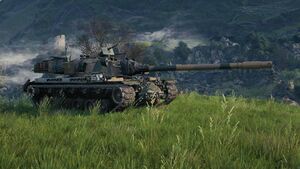T70 Mamaduri
| T70 Mamaduri | |
|---|---|
 | |
| Type | Main battle tank |
| Place of origin | |
| Production history | |
| Designer | Akula Coroporation |
| Designed | 1963-1967 |
| Manufacturer | Akula Corporation |
| Produced | 1967-1990 |
| Specifications | |
| Weight | 50 tonnes (55 short tons; 49 long tons) |
| Length | 10.5 metres (34 ft 5 in) (gun forward) |
| Width | 3.5 metres (11 ft 6 in) |
| Height | 2.7 metres (8 ft 10 in) |
| Crew | 4 (commander, gunner, loader, driver) |
| Armor | Alumina ceramic sandwhiched between layers of steel |
Main armament | Kala G1 120mm smoothbore gun |
Secondary armament | 2 x 12.7 mm machine guns |
| Engine | Akula 10XX-69 10-cylinder diesel engine 1000 hp |
| Power/weight | 20 hp/tonne |
| Transmission | Akula T10-70A |
| Suspension | hydropneumatic suspension |
Operational range | 500 km (310 mi) |
| Speed | 53 km/h (33 mph) on the road 38 km/h (24 mph) off-road |
The T70 Mamaduri was a Tennaiite main battle tank of the Royal Tennaiite Army. It was built by the Akula Corporation as replacement for the earlier T53. It incorporated several advanced and unique features such as steel and alumina ceramic composite armor, a hydropneumatic suspension, a 120mm smoothbore tank gun, and a laser rangefinder. It was followed by the more advanced Sundarji which eventually replaced it. The Mamaduri was retired by the Royal Tennaiite Army in 1990 but remains in service with several other nations in Tyran. Over the course of its over fifty years of active service, the Mamaduri has recieved numerous upgrades that have kept it relevant despite several more modern main battle tanks becoming available since the T70 first entered production and service.
History
Design
Armament
The tank was initially designed to equip the 105mm P18 rifled cannon produced by Konkani Steel Works used in the later marks of the T53, but it was decided that a weapon with greater power would be needed to counteract percieved advances in armor technology abroad. Instead, the army decided upon the then in development Kala G1 120mm smoothbore cannon as the primary weapon of the T70 as it would allow for the use of a wider variety of munitions compared to a rifled gun and provide ample firepower against current and future armors. This decision to adapt the G1 over the P18 along with the addition of extra armor led to the tanks prjected weight rising from 45 tonnes to 50 tonnes. The primary gun could fire a wide variety of ammunitions such as HESH, APDS, HEP, APFSDS, and HEAT-MP. In the 1970s, the ability to fire anti-tank guided missiles was gained by the T70.
The secondory aramament consisted of a 12.7mm anti-aircraft gun and a 12.7mm co-axial machine gun.
Mobility
The T70 is powered by a Akula 10XX-69 10-cylinder diesel engine providing 1000 hp (746 kW). At 20 hp/tonne, its power-to-weight ratio is similar to tanks several tonnes lighter than itself due to its powerful engine. The maximum quoted road speed of the T70 is 53 km/h; however, speeds of least 60 km/h have been achieved.
Armor & Protective Systems
The T70 made use of composite armor, frequently called X18. This made it, along with the Syaran Manticore Main Battle Tank, one of the two earliest tanks to equip composite armor. While the Syaran Manticore made use of fiberglass between layers of steel, the T70 made use of alumina ceramic. The use of composite armor greatly enhanced the survivablity of the T70 without a dramatic increase in weight when compared to steel alone. Allowance was made in the design of the T70 for the addition extra armor if it was deemed necessary. With this design feature, the T70 eventually equipped explosive reactive armor (ERA), non-energetic reactive armor (NERA), and Non-explosive reactive armor (NxRA) modules. An NBC protection system was also fitted to the T70.
Service
Variants
Operators
Former Operators
Tanks of comparable role and era
- Manticore: Approximate Syaran equivalent